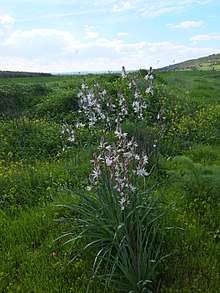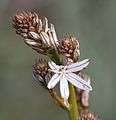Asphodelus aestivus
Asphodelus aestivus, the summer asphodel, is a species of asphodel, a common Western Mediterranean geophyte with a short vertical rhizome and basal leaves. Its flowers are actinomorphic, pinkish-white, with six perianth segments, 14–19 mm long and six stamens of the same length, in two whorls. Its distribution is limited to the Western Mediterranean, mainly found in Portugal and Spain on the European mainland.[2][3] There has been a lot of confusion over the nomenclature and taxonomy of the species, owing to its similarity to Asphodelus ramosus.[4][5] It grows in dry grasslands, phrygana and on rocky or sandy ground.[1]
| Summer asphodel | |
|---|---|
 | |
| Scientific classification | |
| Kingdom: | Plantae |
| Clade: | Tracheophytes |
| Clade: | Angiosperms |
| Clade: | Monocots |
| Order: | Asparagales |
| Family: | Asphodelaceae |
| Subfamily: | Asphodeloideae |
| Genus: | Asphodelus |
| Species: | A. aestivus |
| Binomial name | |
| Asphodelus aestivus Brot. | |
Physical characteristics
The Asphodelus aestivus is a geophyte, having an underground storage organ which enables the plant to survive adverse conditions, such as excessive heat and drought. Its leaves, growing to a height of 60 centimetres (24 in)–80 centimetres (31 in), contain alkaloids that are harmful to sheep and goats in the wet, winter months, but during the summer when their leaves dry out, they lose their toxicity.[6][7] In the Iberian Peninsula it flowers from June to September, although in the Algarve (SW Portugal) it may flower in May or at the end of April. There, the leaves are already withered by the time the plants flower.[8]
Uses
Some traditional folk usages of the plant have been to make a glue from the plant's root. A remedy against warts is also derived from its root.[7] According to Dioscorides, a concoction made from its roots (mixed with wine) induces vomiting.[9] Formerly, the entire plant was used in treating poisonous snake bites (its efficacy yet to be proven scientifically).
Gallery
 The flower of the Asphodelus aestivus
The flower of the Asphodelus aestivus Asphodelus aestivus, in bloom
Asphodelus aestivus, in bloom Asphodelus aestivus, in bloom
Asphodelus aestivus, in bloom
References
| Wikimedia Commons has media related to Asphodelus aestivus. |
- Thacker, H. (2014). "Asphodelus aestivus". IUCN Red List of Threatened Species. 2014: e.T13164287A44541938. doi:10.2305/IUCN.UK.2014-1.RLTS.T13164287A44541938.en.
- "The Euro+Med PlantBase", the information resource for Euro-Mediterranean plant diversity, Botanic Garden and Botanical Museum Berlin-Dahlem, retrieved 2018-03-04
- "Plants of the World Online", the reference for global plant names, Royal Botanic Gardens, Kew, retrieved 2020-08-11
- Lifante, Zoila Díaz; Valdés, Benito (1994). "Lectotypification of Asphodelus ramosus (Asphodelaceae), a Misunderstood Linnaean Name". Taxon. 43 (2): 247–251. doi:10.2307/1222883. JSTOR 1222883.
- "Vascular plants of Greece: an annotated checklist", Englera 31, Botanic Garden and Botanical Museum Berlin-Dahlem, retrieved 2018-03-04
- Rhizopoulou, S. (1997). "Ecophysiological Adaptations of Asphodelus aestivus to Mediterranean Climate Periodicity: Water Relations and Energetic Status". Ecography. 20 (6): 626–633. doi:10.1111/j.1600-0587.1997.tb00431.x. JSTOR 3683251.
- Avi Shmida, MAPA's Dictionary of Plants and Flowers in Israel, Tel-Aviv 2005, s.v. Asphodelus aestivus (p. 77) ISBN 965-521-017-0 (Hebrew)
- See p. 177 in: Díaz Lifante, Zoila (1996). "Reproductive biology of Asphodelus aestivus (Asphodelaceae)". Plant Systematics and Evolution. 200 (3/4): 177–191. doi:10.1007/bf00984934. JSTOR 23642889.
- Dioscorides, De Materia Medica (Book II, § 199).
